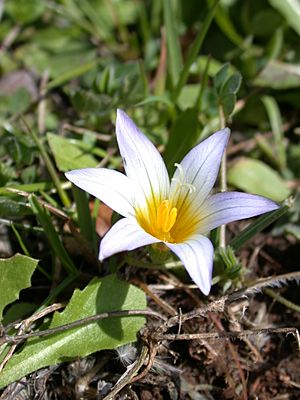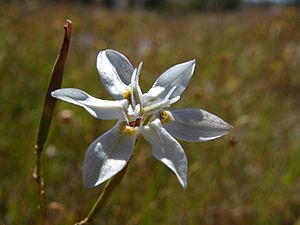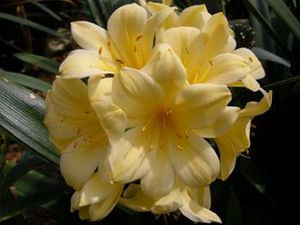Miriam Phoebe de Vos facts for kids
Quick facts for kids
Miriam Phoebe de Vos
|
|
|---|---|
| Born |
Zastron, South Africa
|
| Died | 2005 Stellenbosch, South Africa
|
| Alma mater | Stellenbosch University |
| Known for | Romulea |
| Scientific career | |
| Institutions | University of Cape Town Stellenbosch University |
| Thesis | A cytological study on South African genera of the Aizoaceae and the Proteacea (1940) |
Miriam Phoebe de Vos (born November 26, 1912, in Zastron – died 2005, in Stellenbosch) was a very important South African botanist. A botanist is a scientist who studies plants.
Miriam de Vos was especially good at studying plants that grow from bulbs. She was a top expert on a plant called Romulea. She also loved studying Moraea and Clivia plants.
Contents
Miriam de Vos's Journey in Science
Miriam de Vos started her science journey at the University of Stellenbosch. She earned two degrees there, both with excellent marks.
In 1939, she began working as a junior lecturer at the University of Cape Town. A lecturer is like a teacher at a university.
Becoming a Doctor of Botany
In 1940, Miriam de Vos earned her DSc (Doctor of Science) in Botany from Stellenbosch University. Her special research project was about the tiny cells of certain South African plants.
The next year, in 1941, she joined the Botany Department at the University of Stellenbosch. Here, she taught students about many parts of plants. She taught about cytology (the study of cells), embryology (how plants develop from seeds), and anatomy (the structure of plants).
Her main interests were in how plant cells relate to their classification and how plant embryos grow. She focused a lot on a plant family called Iridaceae, which includes irises and gladioli.
Important Plant Discoveries
Miriam de Vos's first research looked at the cells of Proteaceae and Aizoaceae plants. She also studied how embryos grew in several plant types. Later, she focused on classifying plants in the Iridaceae family.
In 1972, she published a big study on the Romulea genus. This study described how these plants looked and how they were classified. She even identified a new type of Romulea called Romulea elliptica M.P.de Vos. This plant was later declared an endangered species.
Miriam de Vos retired in 1977. But she didn't stop working! She published nine more scientific papers after retiring. These papers helped revise the classification of plants like Tritonia, Crocosmia, Chasmantha, and Ixia. She also helped create the Flora of Namaqualand, which is a book listing all the plants found in that area.
Awards and Honours
Miriam de Vos received several important awards for her work:
- Queen Victoria Stipendium (1935)
- Carnegie bursary (1959)
- Havenga prize for Biology (1974)
Plants Named After Her
Miriam de Vos was so respected that some plants were named in her honour!
- The plant genus Devia was named after her in 1990 by two other South African botanists.
- In 1975, she named the genus Duthiastrum after another botanist, Augusta Vera Duthie.
- In 1988, she named Ixia frederickii to honour Frederick W. Duckitt.
See also
 In Spanish: Miriam Phoebe de Vos para niños
In Spanish: Miriam Phoebe de Vos para niños




